Exhibit 99.4
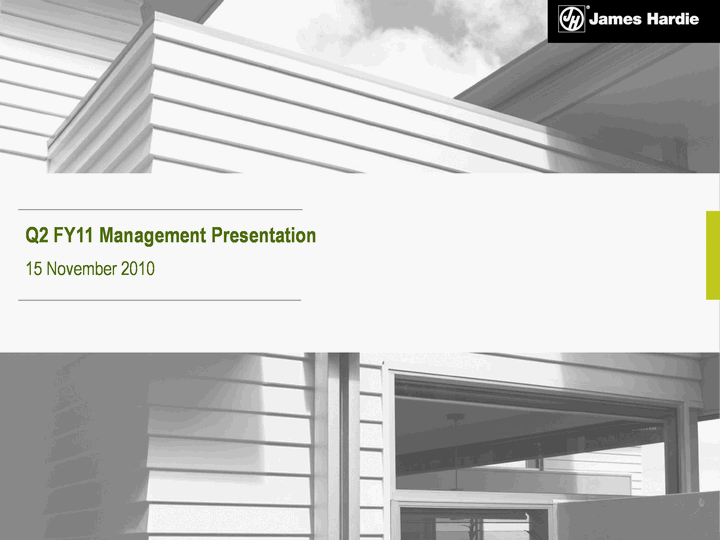
| Q2 FY11 Management Presentation 15 November 2010 |

| Q2 FY11 Management Presentation 15 November 2010 |
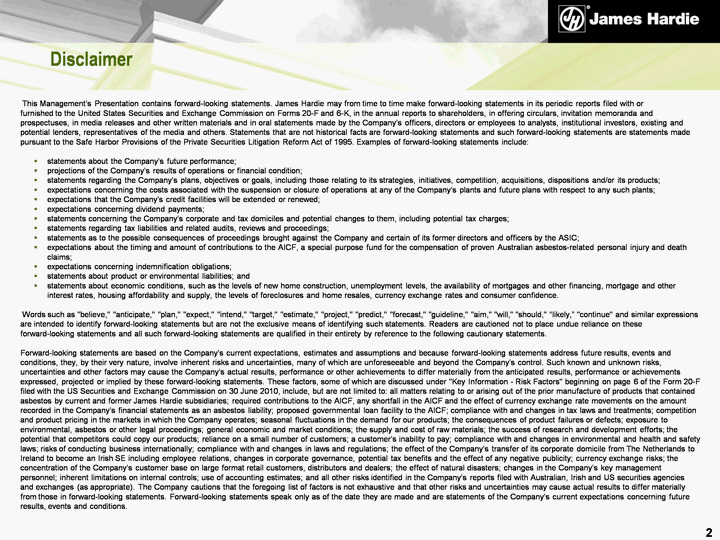
| Disclaimer This Management's Presentation contains forward-looking statements. James Hardie may from time to time make forward-looking statements in its periodic reports filed with or furnished to the United States Securities and Exchange Commission on Forms 20-F and 6-K, in the annual reports to shareholders, in offering circulars, invitation memoranda and prospectuses, in media releases and other written materials and in oral statements made by the Company's officers, directors or employees to analysts, institutional investors, existing and potential lenders, representatives of the media and others. Statements that are not historical facts are forward-looking statements and such forward-looking statements are statements made pursuant to the Safe Harbor Provisions of the Private Securities Litigation Reform Act of 1995. Examples of forward-looking statements include: statements about the Company's future performance; projections of the Company's results of operations or financial condition; statements regarding the Company's plans, objectives or goals, including those relating to its strategies, initiatives, competition, acquisitions, dispositions and/or its products; expectations concerning the costs associated with the suspension or closure of operations at any of the Company's plants and future plans with respect to any such plants; expectations that the Company's credit facilities will be extended or renewed; expectations concerning dividend payments; statements concerning the Company's corporate and tax domiciles and potential changes to them, including potential tax charges; statements regarding tax liabilities and related audits, reviews and proceedings; statements as to the possible consequences of proceedings brought against the Company and certain of its former directors and officers by the ASIC; expectations about the timing and amount of contributions to the AICF, a special purpose fund for the compensation of proven Australian asbestos-related personal injury and death claims; expectations concerning indemnification obligations; statements about product or environmental liabilities; and statements about economic conditions, such as the levels of new home construction, unemployment levels, the availability of mortgages and other financing, mortgage and other interest rates, housing affordability and supply, the levels of foreclosures and home resales, currency exchange rates and consumer confidence. Words such as "believe," "anticipate," "plan," "expect," "intend," "target," "estimate," "project," "predict," "forecast," "guideline," "aim," "will," "should," "likely," "continue" and similar expressions are intended to identify forward-looking statements but are not the exclusive means of identifying such statements. Readers are cautioned not to place undue reliance on these forward-looking statements and all such forward-looking statements are qualified in their entirety by reference to the following cautionary statements. Forward-looking statements are based on the Company's current expectations, estimates and assumptions and because forward-looking statements address future results, events and conditions, they, by their very nature, involve inherent risks and uncertainties, many of which are unforeseeable and beyond the Company's control. Such known and unknown risks, uncertainties and other factors may cause the Company's actual results, performance or other achievements to differ materially from the anticipated results, performance or achievements expressed, projected or implied by these forward-looking statements. These factors, some of which are discussed under "Key Information - Risk Factors" beginning on page 6 of the Form 20-F filed with the US Securities and Exchange Commission on 30 June 2010, include, but are not limited to: all matters relating to or arising out of the prior manufacture of products that contained asbestos by current and former James Hardie subsidiaries; required contributions to the AICF, any shortfall in the AICF and the effect of currency exchange rate movements on the amount recorded in the Company's financial statements as an asbestos liability; proposed governmental loan facility to the AICF; compliance with and changes in tax laws and treatments; competition and product pricing in the markets in which the Company operates; seasonal fluctuations in the demand for our products; the consequences of product failures or defects; exposure to environmental, asbestos or other legal proceedings; general economic and market conditions; the supply and cost of raw materials; the success of research and development efforts; the potential that competitors could copy our products; reliance on a small number of customers; a customer's inability to pay; compliance with and changes in environmental and health and safety laws; risks of conducting business internationally; compliance with and changes in laws and regulations; the effect of the Company's transfer of its corporate domicile from The Netherlands to Ireland to become an Irish SE including employee relations, changes in corporate governance, potential tax benefits and the effect of any negative publicity; currency exchange risks; the concentration of the Company's customer base on large format retail customers, distributors and dealers; the effect of natural disasters; changes in the Company's key management personnel; inherent limitations on internal controls; use of accounting estimates; and all other risks identified in the Company's reports filed with Australian, Irish and US securities agencies and exchanges (as appropriate). The Company cautions that the foregoing list of factors is not exhaustive and that other risks and uncertainties may cause actual results to differ materially from those in forward-looking statements. Forward-looking statements speak only as of the date they are made and are statements of the Company's current expectations concerning future results, events and conditions. 2 |
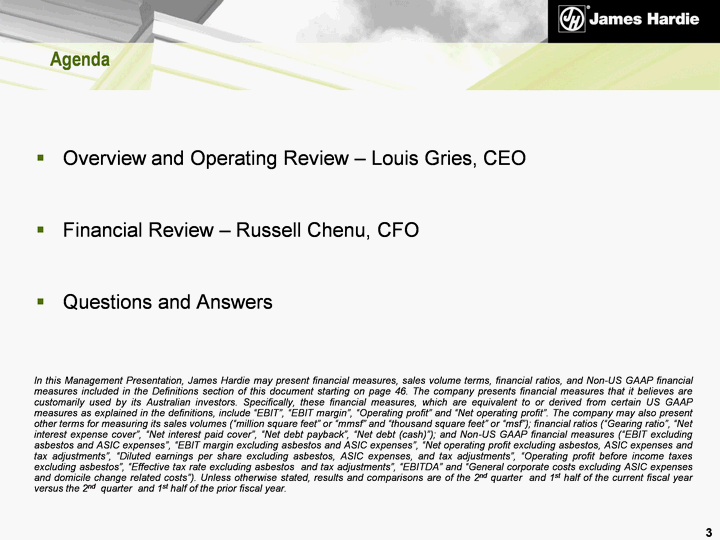
| Agenda Overview and Operating Review - Louis Gries, CEO Financial Review - Russell Chenu, CFO Questions and Answers 3 In this Management Presentation, James Hardie may present financial measures, sales volume terms, financial ratios, and Non-US GAAP financial measures included in the Definitions section of this document starting on page 46. The company presents financial measures that it believes are customarily used by its Australian investors. Specifically, these financial measures, which are equivalent to or derived from certain US GAAP measures as explained in the definitions, include "EBIT", "EBIT margin", "Operating profit" and "Net operating profit". The company may also present other terms for measuring its sales volumes ("million square feet" or "mmsf" and "thousand square feet" or "msf"); financial ratios ("Gearing ratio", "Net interest expense cover", "Net interest paid cover", "Net debt payback", "Net debt (cash)"); and Non-US GAAP financial measures ("EBIT excluding asbestos and ASIC expenses", "EBIT margin excluding asbestos and ASIC expenses", "Net operating profit excluding asbestos, ASIC expenses and tax adjustments", "Diluted earnings per share excluding asbestos, ASIC expenses, and tax adjustments", "Operating profit before income taxes excluding asbestos", "Effective tax rate excluding asbestos and tax adjustments", "EBITDA" and "General corporate costs excluding ASIC expenses and domicile change related costs"). Unless otherwise stated, results and comparisons are of the 2nd quarter and 1st half of the current fiscal year versus the 2nd quarter and 1st half of the prior fiscal year. |
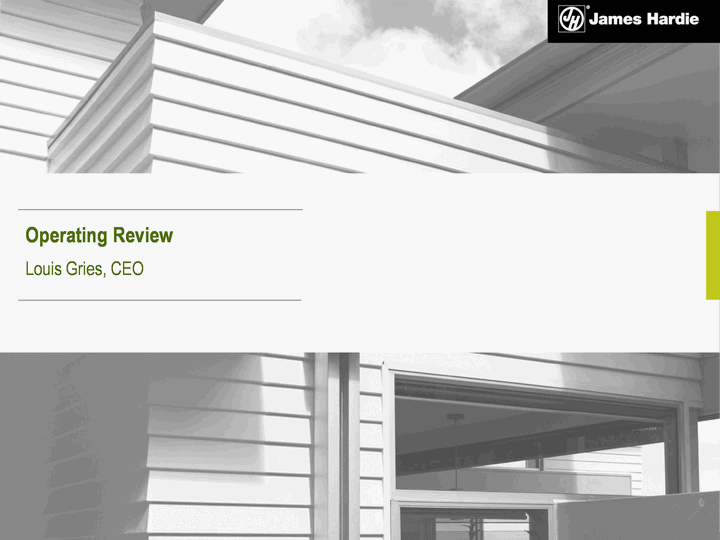
| Operating Review Louis Gries, CEO |
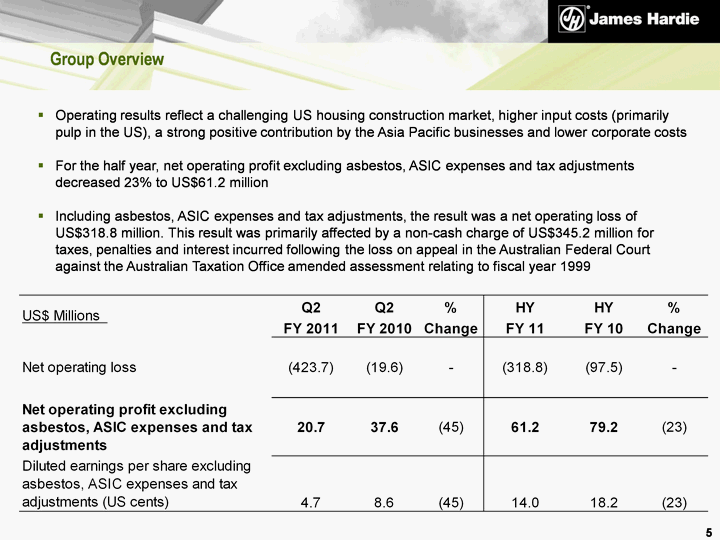
| Group Overview Operating results reflect a challenging US housing construction market, higher input costs (primarily pulp in the US), a strong positive contribution by the Asia Pacific businesses and lower corporate costs For the half year, net operating profit excluding asbestos, ASIC expenses and tax adjustments decreased 23% to US$61.2 million Including asbestos, ASIC expenses and tax adjustments, the result was a net operating loss of US$318.8 million. This result was primarily affected by a non-cash charge of US$345.2 million for taxes, penalties and interest incurred following the loss on appeal in the Australian Federal Court against the Australian Taxation Office amended assessment relating to fiscal year 1999 5 |
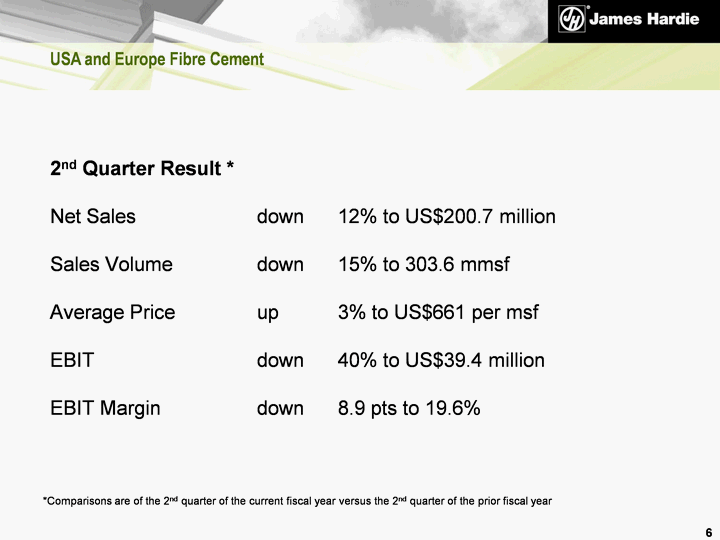
| 2nd Quarter Result * Net Sales down 12% to US$200.7 million Sales Volume down 15% to 303.6 mmsf Average Price up 3% to US$661 per msf EBIT down 40% to US$39.4 million EBIT Margin down 8.9 pts to 19.6% 6 USA and Europe Fibre Cement *Comparisons are of the 2nd quarter of the current fiscal year versus the 2nd quarter of the prior fiscal year |
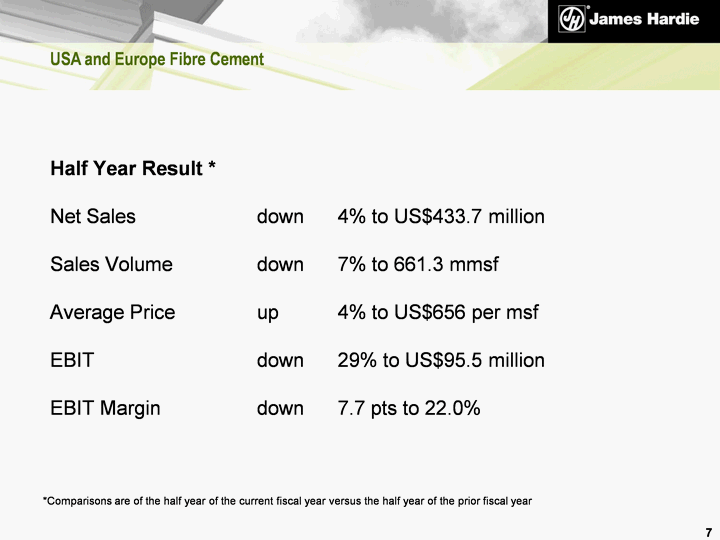
| Half Year Result * Net Sales down 4% to US$433.7 million Sales Volume down 7% to 661.3 mmsf Average Price up 4% to US$656 per msf EBIT down 29% to US$95.5 million EBIT Margin down 7.7 pts to 22.0% 7 USA and Europe Fibre Cement *Comparisons are of the half year of the current fiscal year versus the half year of the prior fiscal year |
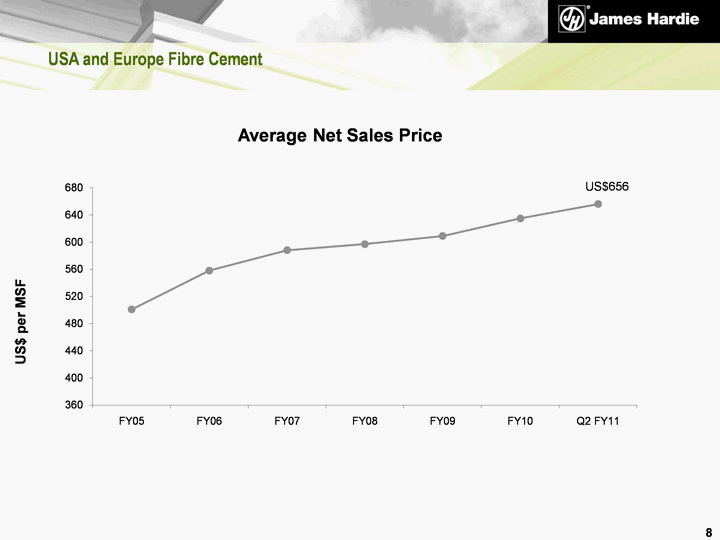
| Average Net Sales Price US$ per MSF USA and Europe Fibre Cement US$656 8 (CHART) |
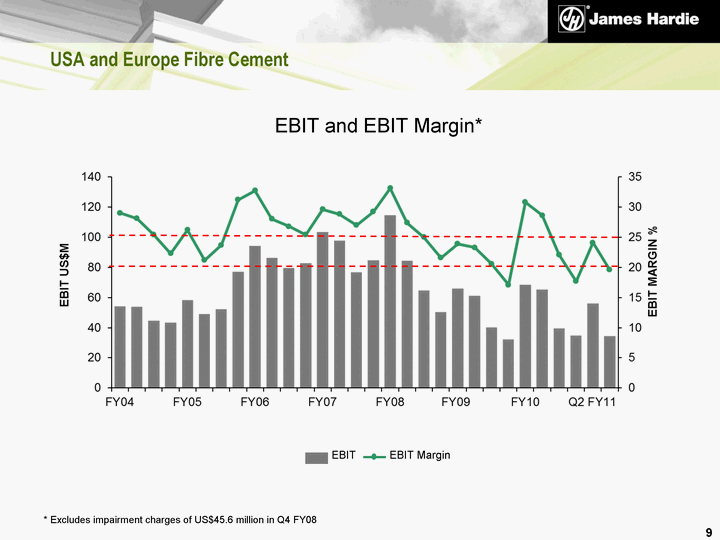
| (CHART) USA and Europe Fibre Cement * Excludes impairment charges of US$45.6 million in Q4 FY08 9 EBIT and EBIT Margin* EBIT EBIT Margin |

| USA Fibre Cement Rolling 12 month average of seasonally adjusted estimate of housing starts by US Census Bureau 10 (CHART) |
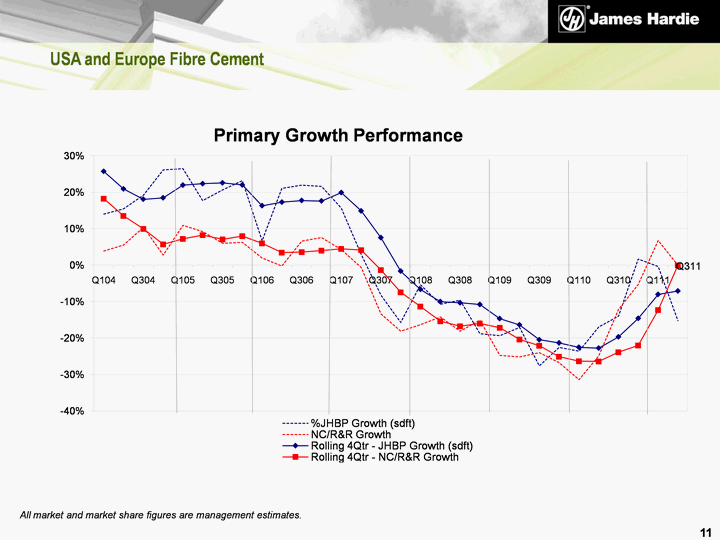
| USA and Europe Fibre Cement Primary Growth Performance All market and market share figures are management estimates. 11 (CHART) Q311 |
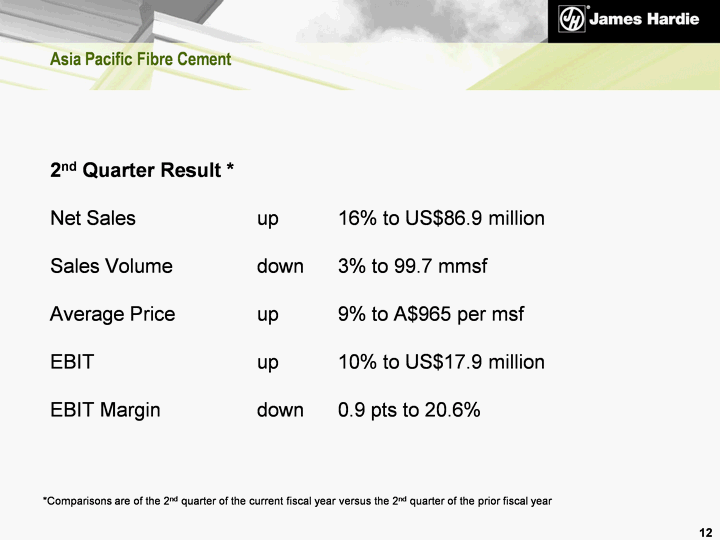
| 2nd Quarter Result * Net Sales up 16% to US$86.9 million Sales Volume down 3% to 99.7 mmsf Average Price up 9% to A$965 per msf EBIT up 10% to US$17.9 million EBIT Margin down 0.9 pts to 20.6% 12 Asia Pacific Fibre Cement *Comparisons are of the 2nd quarter of the current fiscal year versus the 2nd quarter of the prior fiscal year |
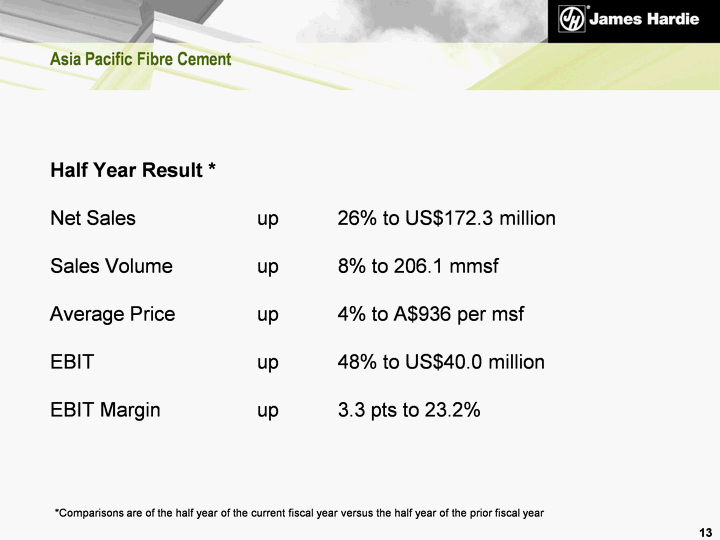
| Half Year Result * Net Sales up 26% to US$172.3 million Sales Volume up 8% to 206.1 mmsf Average Price up 4% to A$936 per msf EBIT up 48% to US$40.0 million EBIT Margin up 3.3 pts to 23.2% 13 Asia Pacific Fibre Cement *Comparisons are of the half year of the current fiscal year versus the half year of the prior fiscal year |

| 14 Group 2nd Quarter Summary* *Comparisons are of the 2nd quarter of the current fiscal year versus the 2nd quarter of the prior fiscal year USA and Europe Fibre Cement results reflected: A challenging operating environment Lower production and sales volumes Higher fixed unit cost of manufacturing following planned inventory reduction Higher input costs - primarily pulp Partially offset by a higher average net sales price and lower SG&A expenses Asia Pacific Fibre Cement results reflected: A solid and improved operating environment Continuing primary demand growth and category share gains Increased sales of higher margin differentiated products Temporary disruption to manufacturing in the Philippines The higher value of Asia Pacific business currencies against the US dollar |
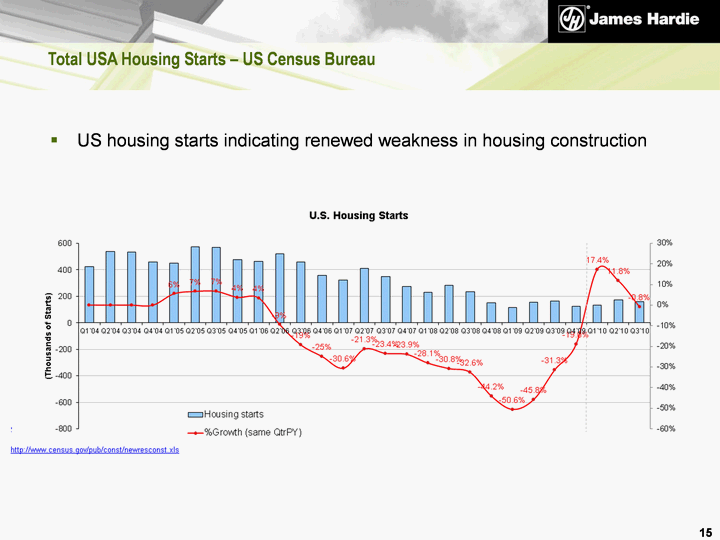
| 15 US housing starts indicating renewed weakness in housing construction Total USA Housing Starts - US Census Bureau |
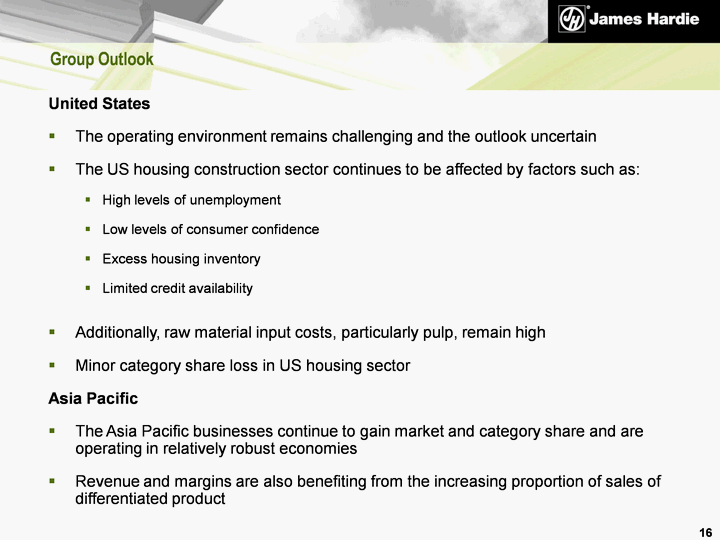
| Group Outlook 16 United States The operating environment remains challenging and the outlook uncertain The US housing construction sector continues to be affected by factors such as: High levels of unemployment Low levels of consumer confidence Excess housing inventory Limited credit availability Additionally, raw material input costs, particularly pulp, remain high Minor category share loss in US housing sector Asia Pacific The Asia Pacific businesses continue to gain market and category share and are operating in relatively robust economies Revenue and margins are also benefiting from the increasing proportion of sales of differentiated product |
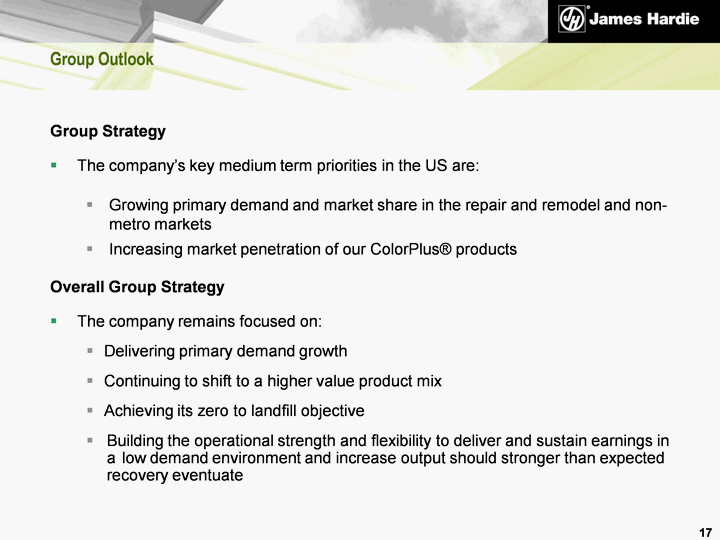
| 17 Group Outlook Group Strategy The company's key medium term priorities in the US are: Growing primary demand and market share in the repair and remodel and non- metro markets Increasing market penetration of our ColorPlus(r) products Overall Group Strategy The company remains focused on: Delivering primary demand growth Continuing to shift to a higher value product mix Achieving its zero to landfill objective Building the operational strength and flexibility to deliver and sustain earnings in a low demand environment and increase output should stronger than expected recovery eventuate |
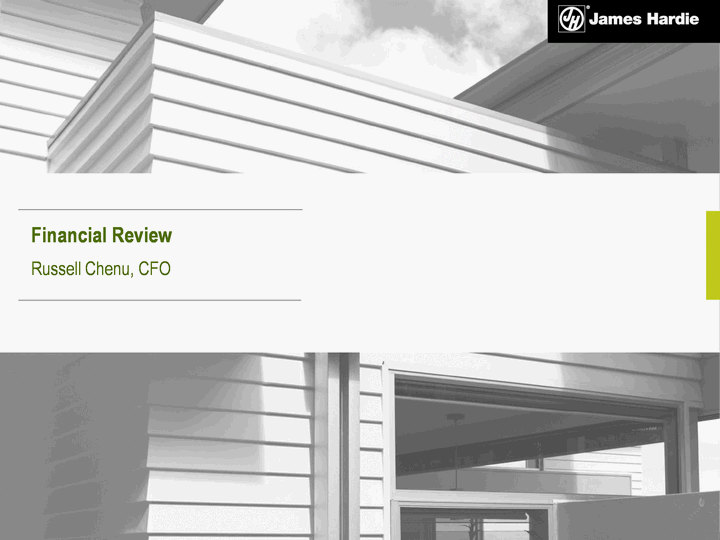
| Financial Review Russell Chenu, CFO |

| Overview* 19 *Comparisons are of the half year of the current fiscal year versus the half year of the prior fiscal year Operations US earnings continue to be affected by weak activity in US housing sector Group earnings benefited from: The strong contribution of Asia Pacific businesses The strength of Asia Pacific business segment's currencies Higher average net sales price Lower corporate costs Management advises that full year earnings excluding asbestos, ASIC expenses and tax adjustments are anticipated to be at the lower end of the range of US$110m to US$125m |
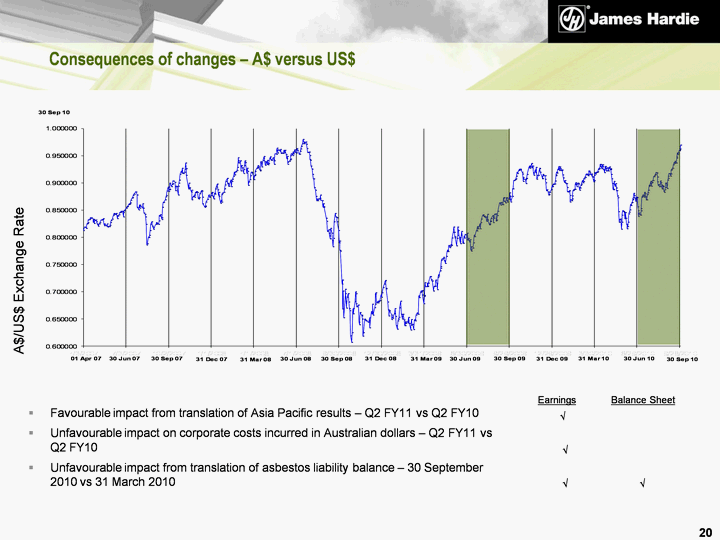
| Consequences of changes - A$ versus US$ A$/US$ Exchange Rate Favourable impact from translation of Asia Pacific results - Q2 FY11 vs Q2 FY10 Unfavourable impact on corporate costs incurred in Australian dollars - Q2 FY11 vs Q2 FY10 Unfavourable impact from translation of asbestos liability balance - 30 September 2010 vs 31 March 2010 20 Earnings Balance Sheet ^ ^ ^ ^ |
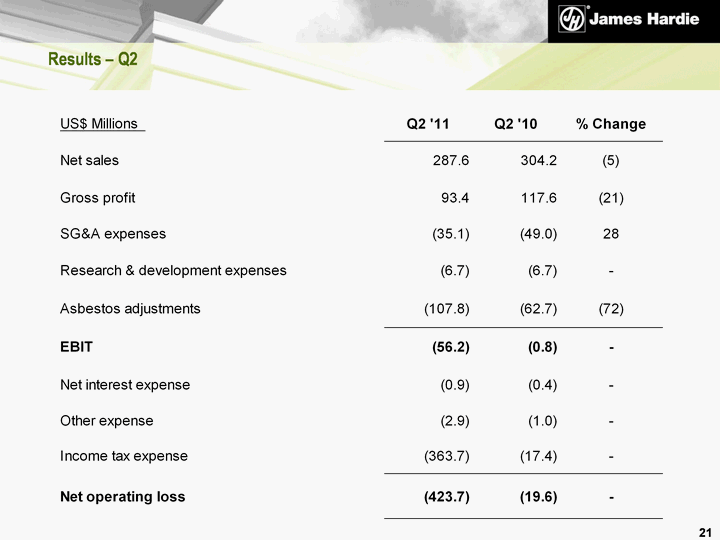
| Results - Q2 21 |
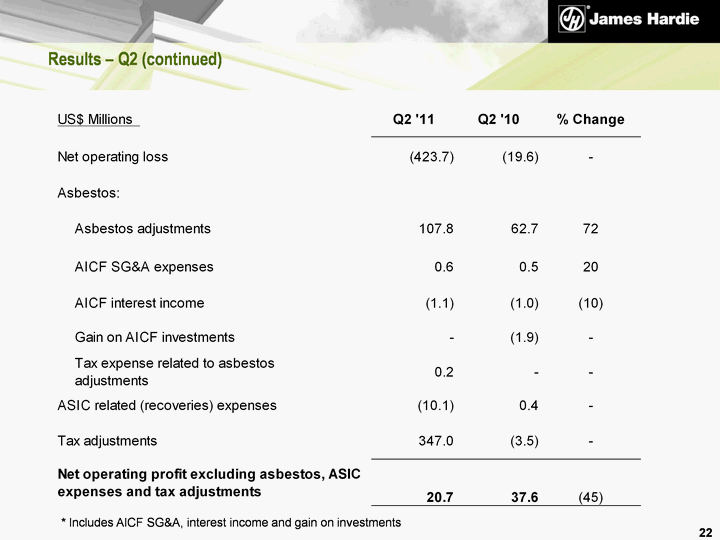
| Results - Q2 (continued) 22 * Includes AICF SG&A, interest income and gain on investments |
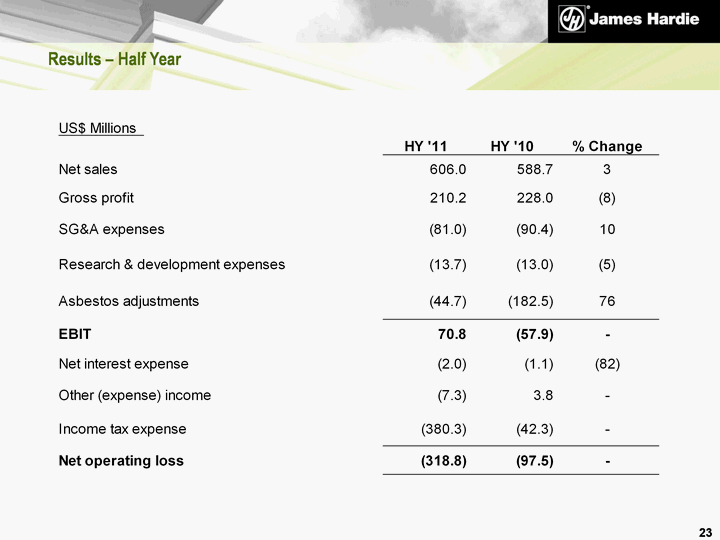
| Results - Half Year 23 |
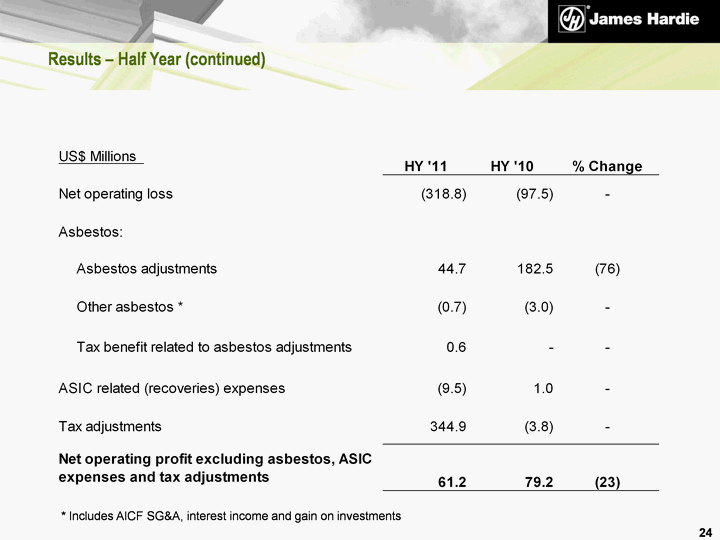
| Results - Half Year (continued) 24 * Includes AICF SG&A, interest income and gain on investments |

| Segment Net Sales - Q2 25 |
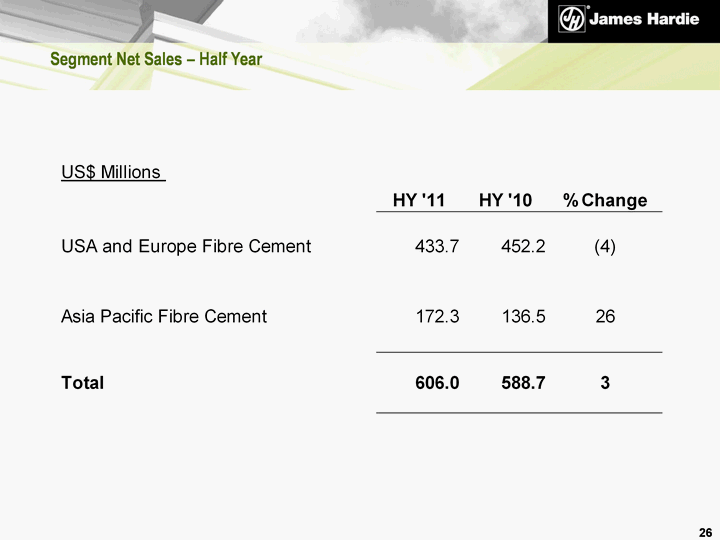
| Segment Net Sales - Half Year 26 |
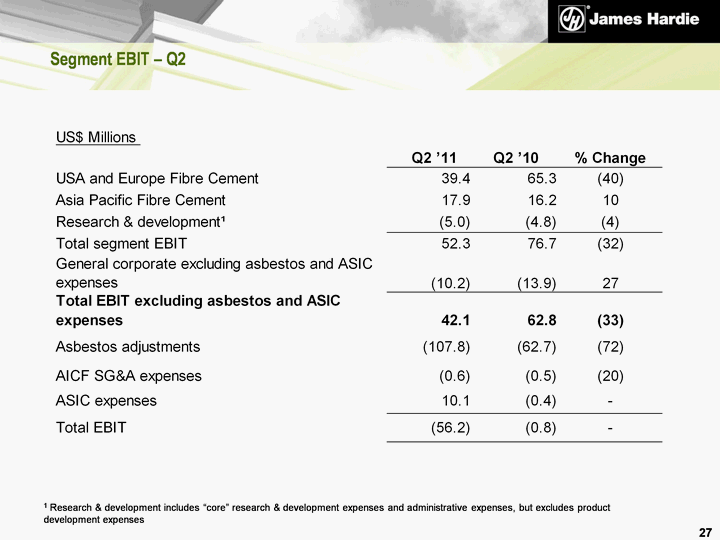
| 1 Research & development includes "core" research & development expenses and administrative expenses, but excludes product development expenses Segment EBIT - Q2 27 |

| 1 Research & development includes "core" research & development expenses and administrative expenses, but excludes product development expenses Segment EBIT - Half Year 28 |
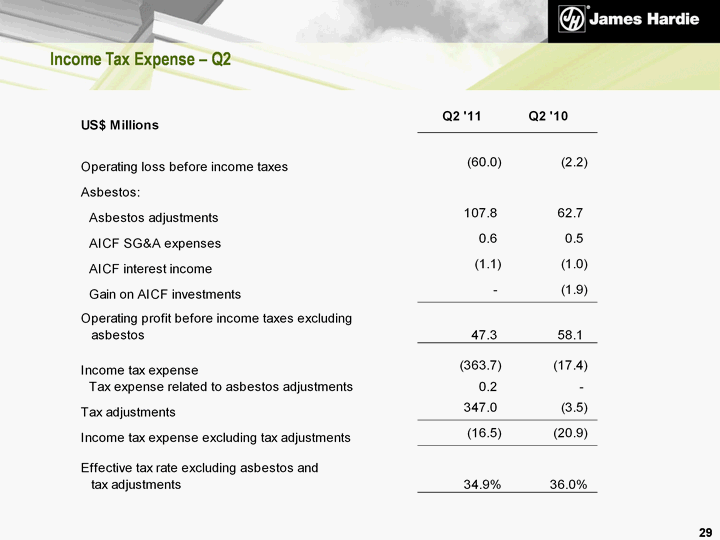
| Income Tax Expense - Q2 29 |
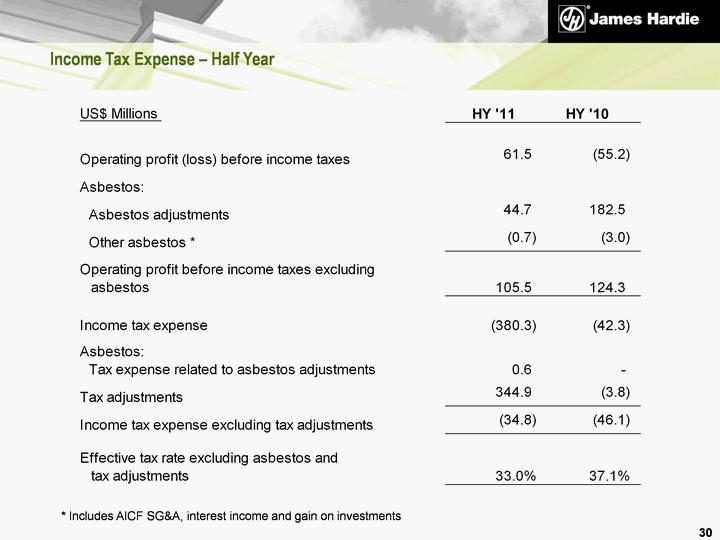
| Income Tax Expense - Half Year 30 * Includes AICF SG&A, interest income and gain on investments |
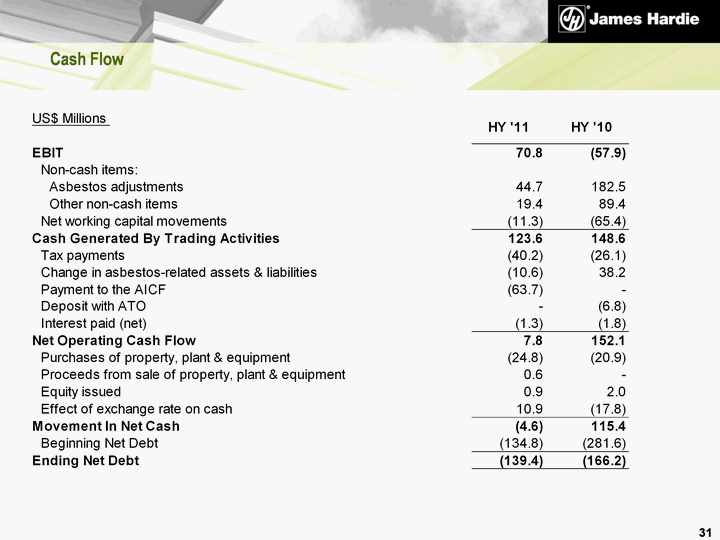
| Cash Flow 31 |
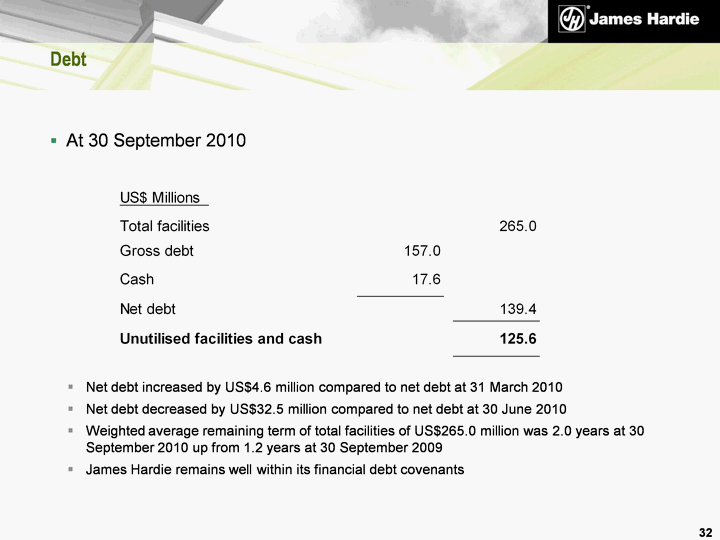
| Debt Net debt increased by US$4.6 million compared to net debt at 31 March 2010 Net debt decreased by US$32.5 million compared to net debt at 30 June 2010 Weighted average remaining term of total facilities of US$265.0 million was 2.0 years at 30 September 2010 up from 1.2 years at 30 September 2009 James Hardie remains well within its financial debt covenants 32 At 30 September 2010 |
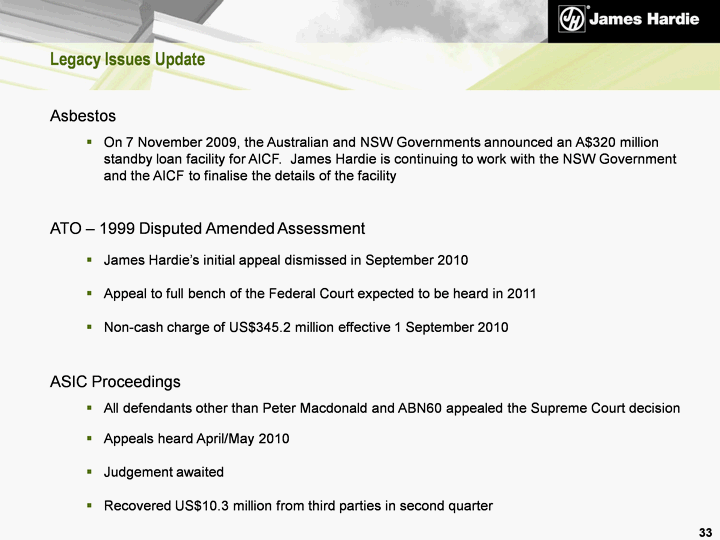
| Legacy Issues Update 33 Asbestos On 7 November 2009, the Australian and NSW Governments announced an A$320 million standby loan facility for AICF. James Hardie is continuing to work with the NSW Government and the AICF to finalise the details of the facility ATO - 1999 Disputed Amended Assessment James Hardie's initial appeal dismissed in September 2010 Appeal to full bench of the Federal Court expected to be heard in 2011 Non-cash charge of US$345.2 million effective 1 September 2010 ASIC Proceedings All defendants other than Peter Macdonald and ABN60 appealed the Supreme Court decision Appeals heard April/May 2010 Judgement awaited Recovered US$10.3 million from third parties in second quarter |
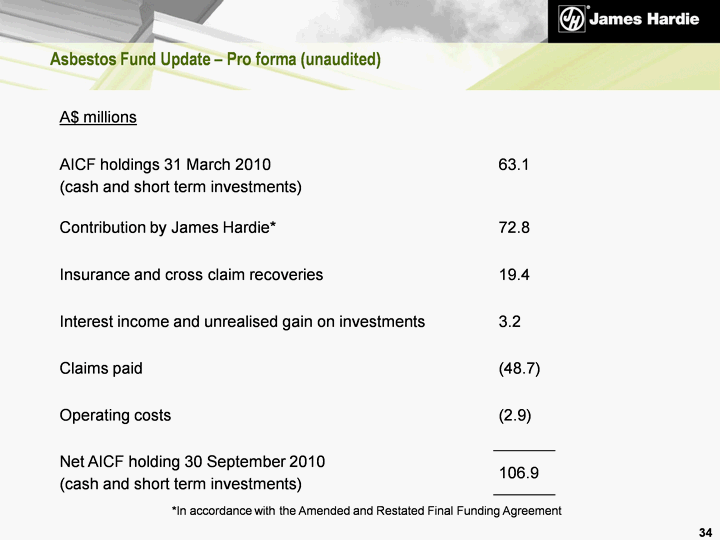
| Asbestos Fund Update - Pro forma (unaudited) 34 *In accordance with the Amended and Restated Final Funding Agreement A$ millions AICF holdings 31 March 2010 (cash and short term investments) 63.1 Contribution by James Hardie* 72.8 Insurance and cross claim recoveries 19.4 Interest income and unrealised gain on investments 3.2 Claims paid (48.7) Operating costs (2.9) Net AICF holding 30 September 2010 (cash and short term investments) 106.9 |
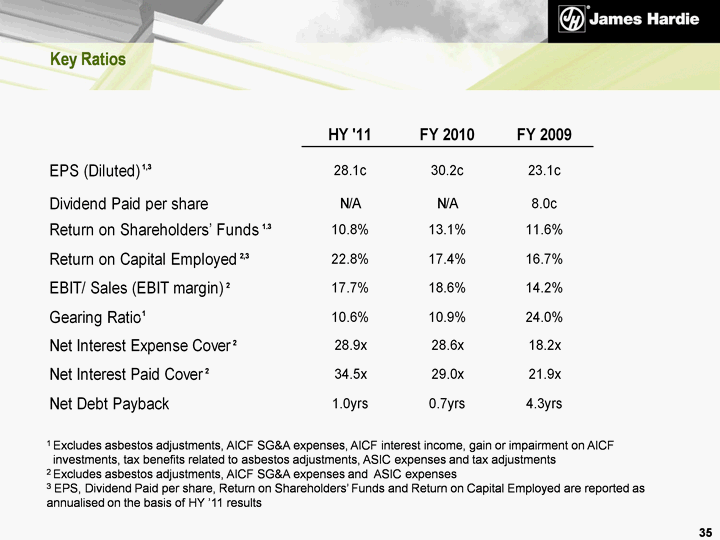
| Key Ratios 1 Excludes asbestos adjustments, AICF SG&A expenses, AICF interest income, gain or impairment on AICF investments, tax benefits related to asbestos adjustments, ASIC expenses and tax adjustments 2 Excludes asbestos adjustments, AICF SG&A expenses and ASIC expenses 3 EPS, Dividend Paid per share, Return on Shareholders' Funds and Return on Capital Employed are reported as annualised on the basis of HY '11 results 35 |
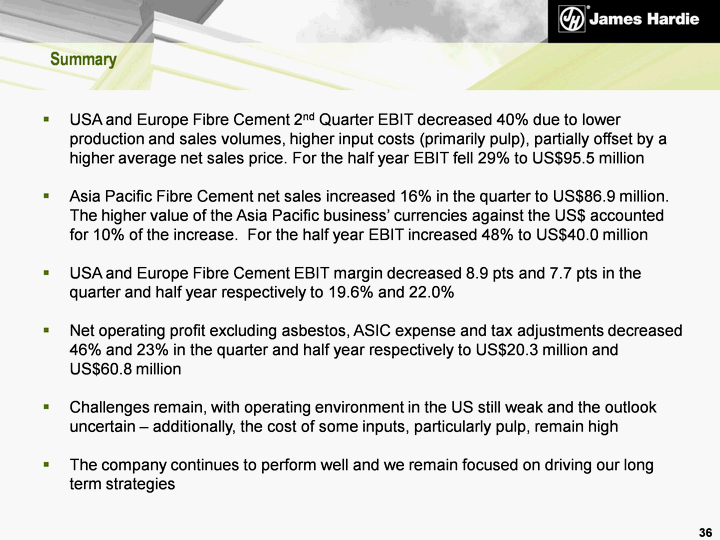
| 36 Summary USA and Europe Fibre Cement 2nd Quarter EBIT decreased 40% due to lower production and sales volumes, higher input costs (primarily pulp), partially offset by a higher average net sales price. For the half year EBIT fell 29% to US$95.5 million Asia Pacific Fibre Cement net sales increased 16% in the quarter to US$86.9 million. The higher value of the Asia Pacific business' currencies against the US$ accounted for 10% of the increase. For the half year EBIT increased 48% to US$40.0 million USA and Europe Fibre Cement EBIT margin decreased 8.9 pts and 7.7 pts in the quarter and half year respectively to 19.6% and 22.0% Net operating profit excluding asbestos, ASIC expense and tax adjustments decreased 46% and 23% in the quarter and half year respectively to US$20.3 million and US$60.8 million Challenges remain, with operating environment in the US still weak and the outlook uncertain - additionally, the cost of some inputs, particularly pulp, remain high The company continues to perform well and we remain focused on driving our long term strategies |

| Questions and Answers |
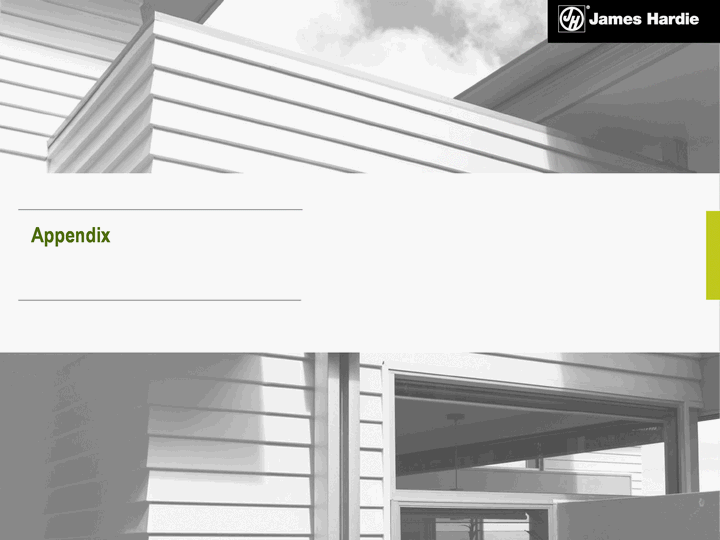
| Appendix |
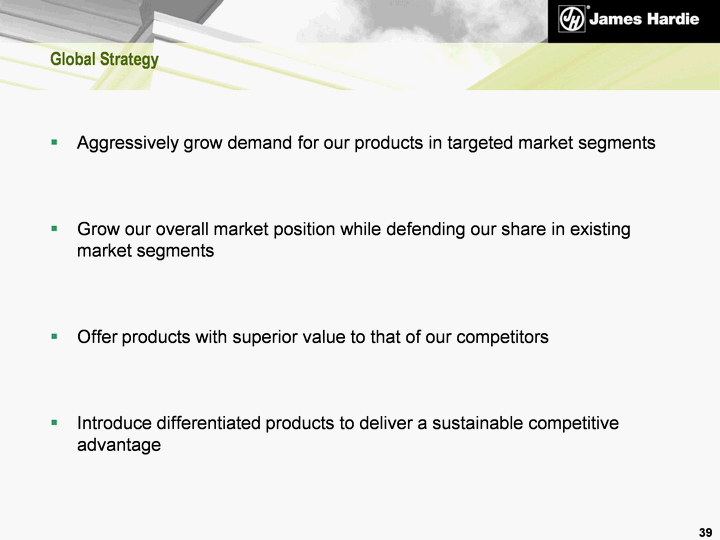
| Aggressively grow demand for our products in targeted market segments Grow our overall market position while defending our share in existing market segments Offer products with superior value to that of our competitors Introduce differentiated products to deliver a sustainable competitive advantage 39 Global Strategy |
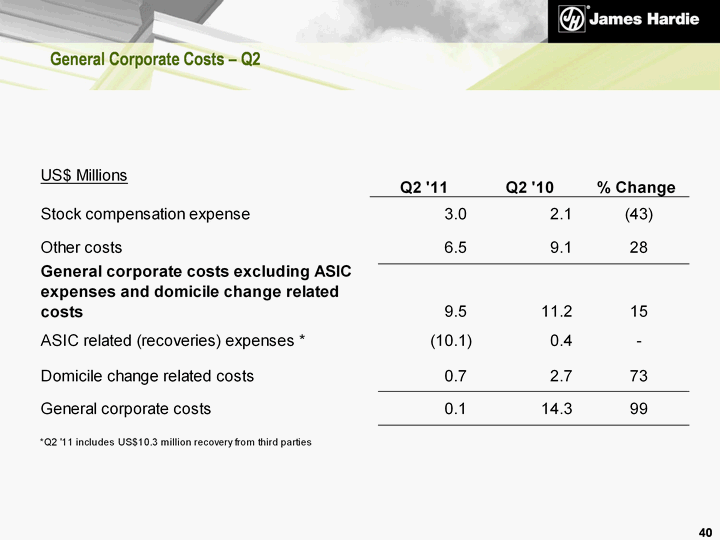
| General Corporate Costs - Q2 40 |
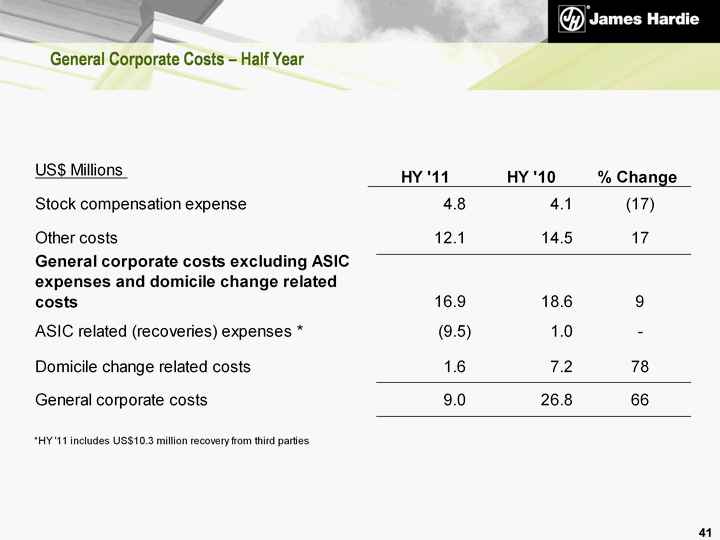
| General Corporate Costs - Half Year 41 |
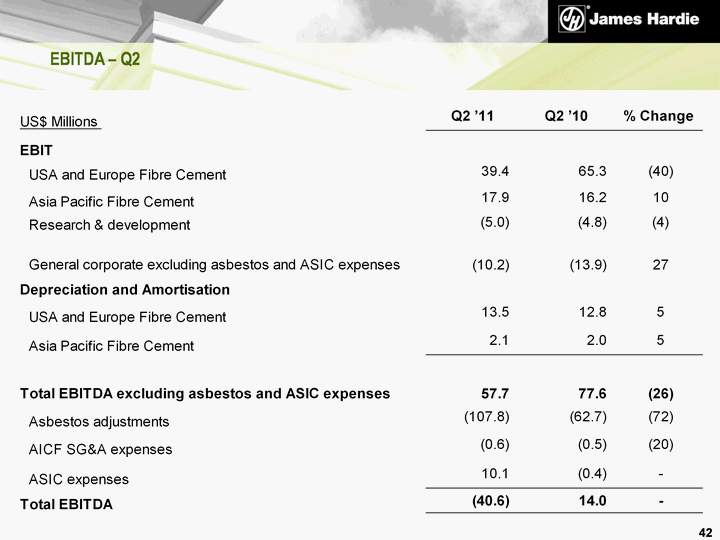
| EBITDA - Q2 42 |
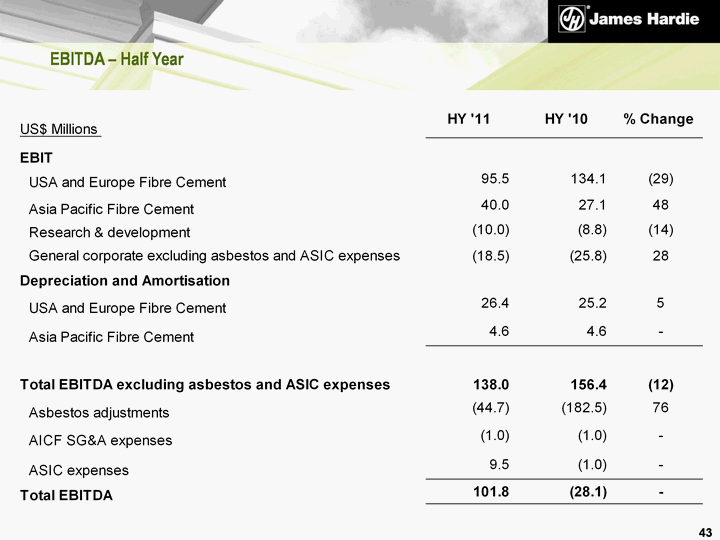
| EBITDA - Half Year 43 |

| Capital Expenditure 44 |

| Net Interest Expense 45 |
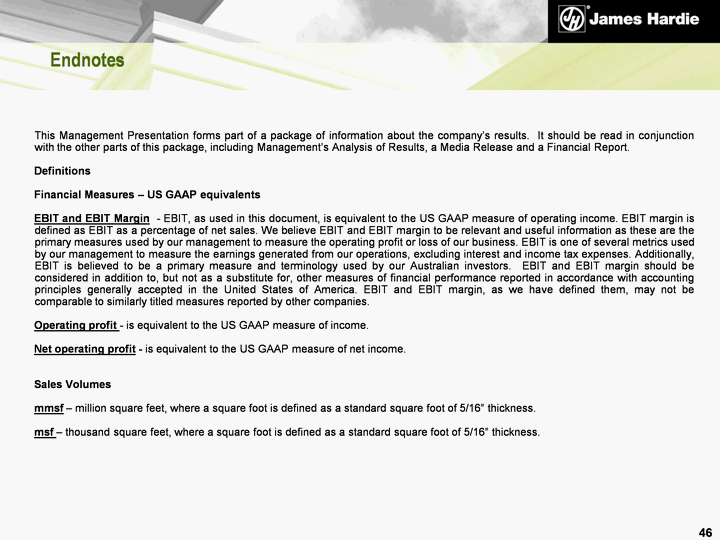
| Endnotes This Management Presentation forms part of a package of information about the company's results. It should be read in conjunction with the other parts of this package, including Management's Analysis of Results, a Media Release and a Financial Report. Definitions Financial Measures - US GAAP equivalents EBIT and EBIT Margin - EBIT, as used in this document, is equivalent to the US GAAP measure of operating income. EBIT margin is defined as EBIT as a percentage of net sales. We believe EBIT and EBIT margin to be relevant and useful information as these are the primary measures used by our management to measure the operating profit or loss of our business. EBIT is one of several metrics used by our management to measure the earnings generated from our operations, excluding interest and income tax expenses. Additionally, EBIT is believed to be a primary measure and terminology used by our Australian investors. EBIT and EBIT margin should be considered in addition to, but not as a substitute for, other measures of financial performance reported in accordance with accounting principles generally accepted in the United States of America. EBIT and EBIT margin, as we have defined them, may not be comparable to similarly titled measures reported by other companies. Operating profit - is equivalent to the US GAAP measure of income. Net operating profit - is equivalent to the US GAAP measure of net income. Sales Volumes mmsf - million square feet, where a square foot is defined as a standard square foot of 5/16" thickness. msf - thousand square feet, where a square foot is defined as a standard square foot of 5/16" thickness. 46 |
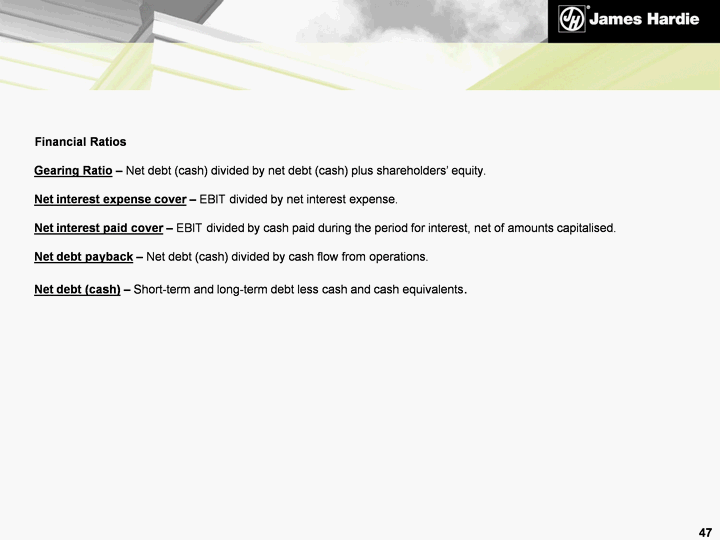
| Financial Ratios Gearing Ratio - Net debt (cash) divided by net debt (cash) plus shareholders' equity. Net interest expense cover - EBIT divided by net interest expense. Net interest paid cover - EBIT divided by cash paid during the period for interest, net of amounts capitalised. Net debt payback - Net debt (cash) divided by cash flow from operations. Net debt (cash) - Short-term and long-term debt less cash and cash equivalents. 47 |
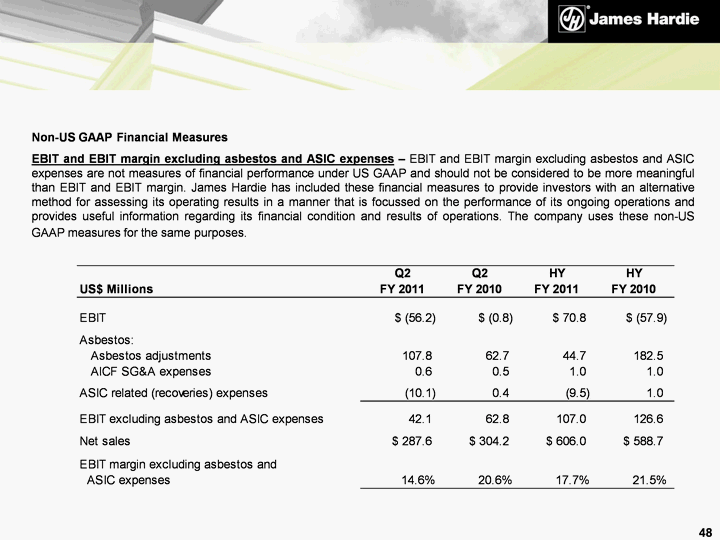
| Non-US GAAP Financial Measures EBIT and EBIT margin excluding asbestos and ASIC expenses - EBIT and EBIT margin excluding asbestos and ASIC expenses are not measures of financial performance under US GAAP and should not be considered to be more meaningful than EBIT and EBIT margin. James Hardie has included these financial measures to provide investors with an alternative method for assessing its operating results in a manner that is focussed on the performance of its ongoing operations and provides useful information regarding its financial condition and results of operations. The company uses these non-US GAAP measures for the same purposes. 48 |

| Non-US GAAP Financial Measures (continued) Net operating profit excluding asbestos, ASIC expenses and tax adjustments - Net operating profit excluding asbestos, ASIC expenses and tax adjustments is not a measure of financial performance under US GAAP and should not be considered to be more meaningful than net income. The company has included this financial measure to provide investors with an alternative method for assessing its operating results in a manner that is focussed on the performance of its ongoing operations. The company uses this non-US GAAP measure for the same purposes. 49 |
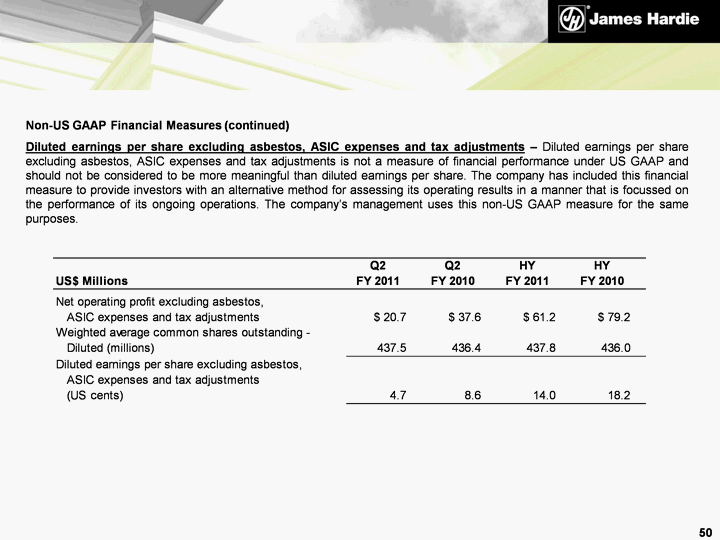
| Non-US GAAP Financial Measures (continued) Diluted earnings per share excluding asbestos, ASIC expenses and tax adjustments - Diluted earnings per share excluding asbestos, ASIC expenses and tax adjustments is not a measure of financial performance under US GAAP and should not be considered to be more meaningful than diluted earnings per share. The company has included this financial measure to provide investors with an alternative method for assessing its operating results in a manner that is focussed on the performance of its ongoing operations. The company's management uses this non-US GAAP measure for the same purposes. 50 |
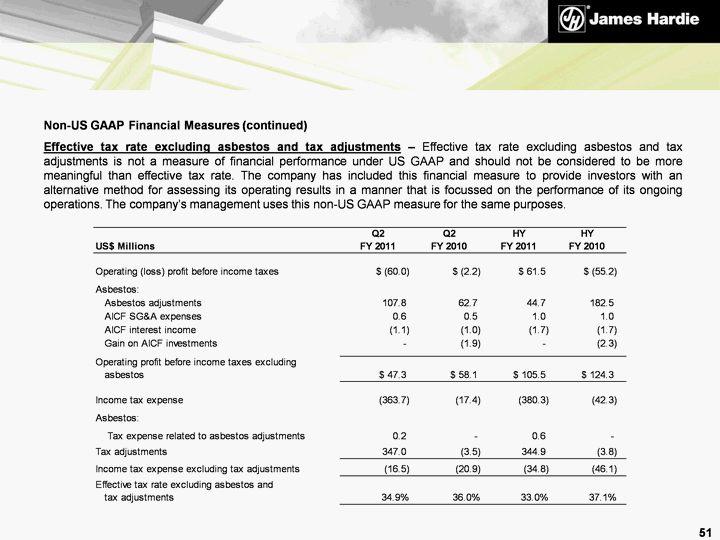
| Non-US GAAP Financial Measures (continued) Effective tax rate excluding asbestos and tax adjustments - Effective tax rate excluding asbestos and tax adjustments is not a measure of financial performance under US GAAP and should not be considered to be more meaningful than effective tax rate. The company has included this financial measure to provide investors with an alternative method for assessing its operating results in a manner that is focussed on the performance of its ongoing operations. The company's management uses this non-US GAAP measure for the same purposes. 51 |
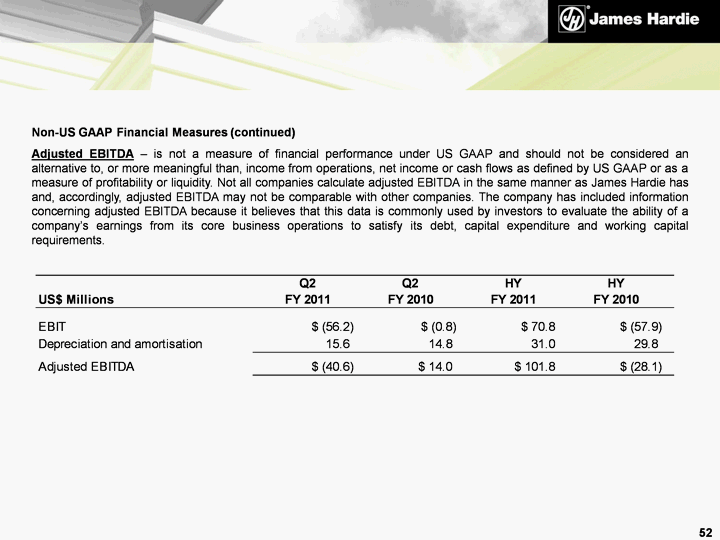
| Non-US GAAP Financial Measures (continued) Adjusted EBITDA - is not a measure of financial performance under US GAAP and should not be considered an alternative to, or more meaningful than, income from operations, net income or cash flows as defined by US GAAP or as a measure of profitability or liquidity. Not all companies calculate adjusted EBITDA in the same manner as James Hardie has and, accordingly, adjusted EBITDA may not be comparable with other companies. The company has included information concerning adjusted EBITDA because it believes that this data is commonly used by investors to evaluate the ability of a company's earnings from its core business operations to satisfy its debt, capital expenditure and working capital requirements. 52 |

| Non-US GAAP Financial Measures (continued) General corporate costs excluding ASIC expenses and domicile change related costs - General corporate costs excluding ASIC expenses and domicile change related costs is not a measure of financial performance under US GAAP and should not be considered to be more meaningful than general corporate costs. James Hardie has included these financial measures to provide investors with an alternative method for assessing its operating results in a manner that is focussed on the performance of its ongoing operations and provides useful information regarding its financial condition and results of operations. The company uses these non-US GAAP measures for the same purposes. 53 |
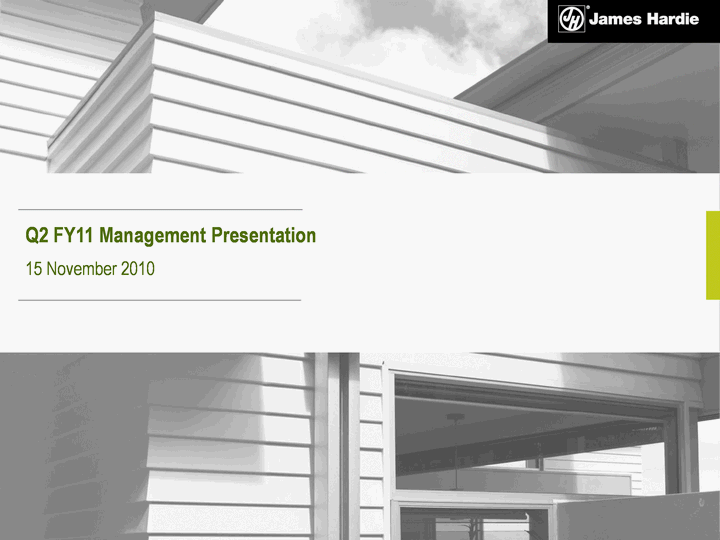
| Q2 FY11 Management Presentation 15 November 2010 |